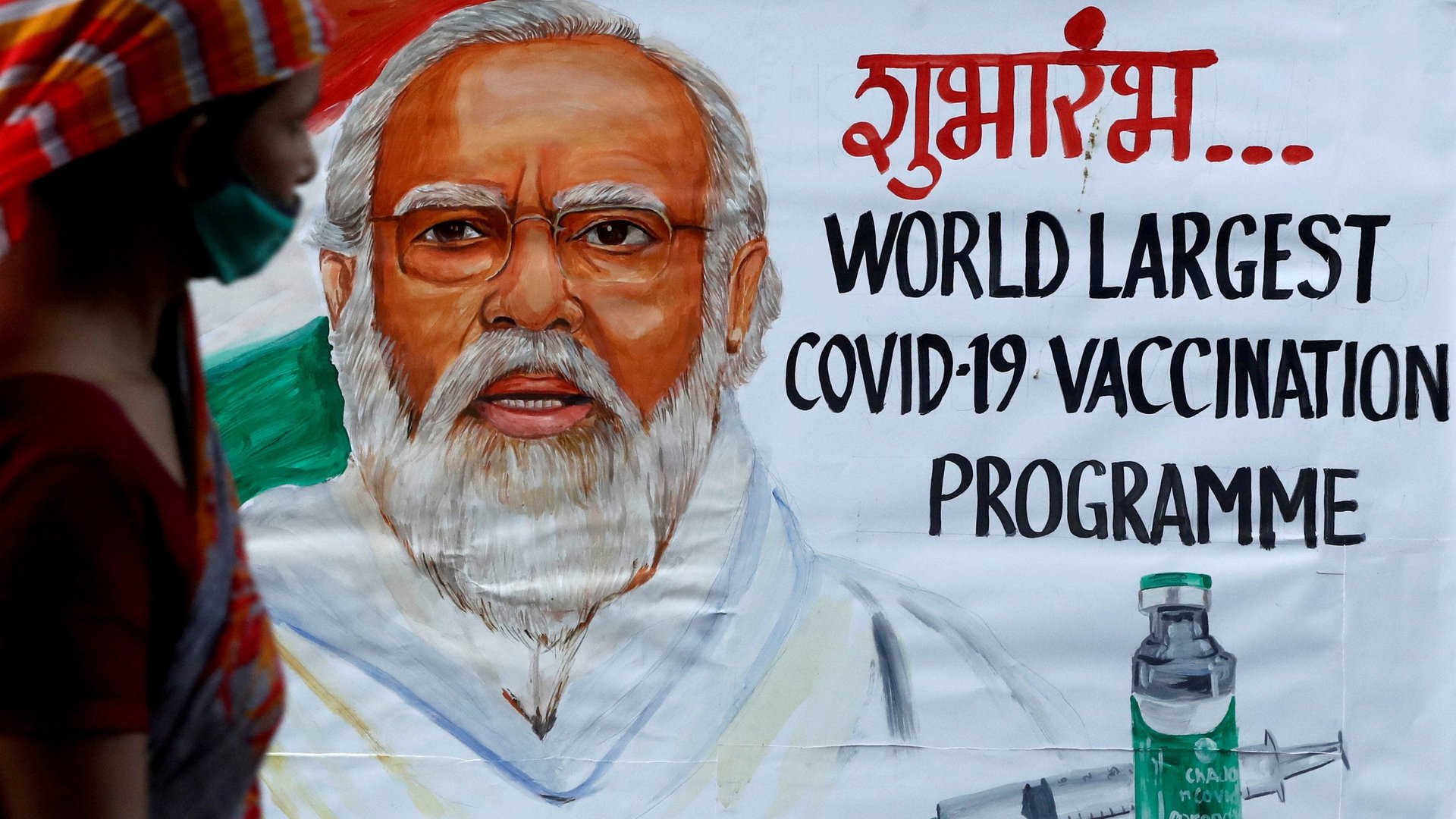Why has Narendra Modi not taken the Covid-19 vaccine yet?
Joe Biden did it, Benjamin Netanyahu did it, even Mike Pence did it. But Narendra Modi has not—yet.


Joe Biden did it, Benjamin Netanyahu did it, even Mike Pence did it. But Narendra Modi has not—yet.
As world leaders step forward to take the Covid-19 jab in their countries, prime minister Modi will likely take the shot only in the second phase of India’s rollout. India began vaccinating its healthcare and frontline workers on Jan. 16. After it completes this demographic of 30 million people, the government will roll out the vaccine for those above 50 years, and those below 50 but with co-morbidities.
India has vaccinated over 7 million healthcare and frontline workers so far and hopes to inoculate 300 million Indians by August.
This second phase is when India’s leading politicians, including the Indian president and state chief ministers, are expected to take the vaccine against coronavirus, which has infected nearly 11 million and killed over 150,000 people in the country.
But the delay in Modi taking this jab is sending out a mixed message. For one, it does nothing to assuage the fears against vaccines and the scepticism in the medical community.
Vaccine hesitancy in India
India approved two vaccines—Covishield made from the Oxford-AstraZeneca vaccine’s master seed, and Bharat Biotech’s Covaxin—for emergency use on Jan. 3.
While Covishield has some data on efficacy based on the Oxford-AstraZeneca trials elsewhere in the world, Covaxin, which has been developed in association with the Indian government’s medical research arm, lacks efficacy data at the moment. Its phase 3 trials are still underway, which has led the Indian scientific community to raise serious doubts over why this vaccine was approved at all.
This hesitancy seeped in when some healthcare workers who were due to receive the Covaxin shot decided to skip their turn. Doctors at Delhi’s Ram Manohar Lohia Hospital wrote a letter to the administration asking that their staff be administered Covishield instead of Covaxin.
Yesterday (Feb. 11), TS Singh Deo, a cabinet minister from the state of Chhattisgarh, wrote to India’s health minister Harsh Vardhan requesting that the central government only supply Covaxin to the state after valid trial data are available.
Covaxin’s missing trial data aside, vaccine hesitancy threatens to slow down the rollout in India. Some members of the medical community have said that Modi, who has been consistent with his messaging about wearing masks and staying at home, could go a long way in calming the nerves of vaccine recipients by taking the jab on camera. “Our Prime Minister is a charismatic leader. We follow his advice in letter and spirit. I believe if he takes the vaccine, the hesitancy will go away among all sections of society,” Dr Rahul Bhargava from Fortis Hospital in Gurugram told Outlook magazine.
This sentiment was also echoed by several politicians, including Dayanidhi Maran, a parliamentarian from Tamil Nadu, who spoke about it in the lower house on Feb. 10.
But there is likely another reason why Modi has chosen to delay his jab.
The optics of a Covid-19 vaccine
In a meeting with all state chief ministers of the country on Jan. 13, three days before the Covid-19 vaccine rollout, Modi reportedly told the attendees that no government functionary would be allowed to cut the vaccine queue. “Prime minister during the video conference has stated that no politician, even by mistake, will not take the vaccine because the first right on the vaccine is for frontline and healthcare workers,” Himanta Biswa Sarma, the health minister for the eastern state of Assam, said during a press interaction.
It is likely that Modi wants to be seen as an egalitarian leader, one who does not use his power or influence for personal gain. This is in line with his campaign promises of “na khaaunga, na khaane dunga” (I won’t take bribes, nor will I let anyone take bribes) during the 2014 general elections. At the time he was signalling the anti-corruption wave in India against the Congress-led government of the day, as well as against political nepotism.
Modi’s own sartorial choices—including expensive eyeglasses and a designer suit—and his large travel bills had become a point of much debate. Rahul Gandhi of the Congress, in 2015, had called the Modi government “suit-boot ki sarkar” (a government of suits and boots). He has often repeated this jibe, most recently during India’s ongoing farmer-led protests.